A tricky two-game stretch to open the season now sees South Carolina come to town for the two squads’ first meeting since 2017. Recent history has not been kind to the Hogs here, as they’ve lost three straight dating back to 2012.
We introduced the Gamecocks earlier this week. Since 1993, when Arkansas beats South Carolina, they finish above .500, when they lose to South Carolina, they finish .500 or worse. That’s held true for each of the last 21 meetings between these teams. Given the difficulty of the Razorbacks’ schedule, this is shaping up to be another bellwether game. A win, and this season could be special, but a loss, and the Hogs will likely be fighting for 7-5.
Meet the Gamecocks
Confused by any of the advanced stats you see here? Be sure to check out the glossary.
South Carolina is 1-0, courtesy of a 35-14 win over Georgia State last week. It was 20-14 late in the third quarter, and then the Gamecocks proceeded to block two punts for touchdowns over the game’s final 20 minutes to provide the final margin.
This matchup is interesting in that South Carolina is the clear underdog and upstart team. That’s been the Hogs for the last few years. Sam Pittman has done an incredible job of motivating a team of underdogs… now he has motivate a team of favorites. It’s a different and often more difficult task.
All of the advanced stats you see have been weighted. One week isn’t enough data to start making declarations, so the final six weeks of the 2021 season are still in the data with a lesser weight. Over the next few weeks, the weights of the 2021 data will decrease until, about three or four weeks from now, all data from last year will be gone and we’ll be using data from this season only.

The Consistency and Momentum grades are blank for now as they don’t exist yet for this season. The Hogs have the #1 resume (hang the banner!) by virtue of having the best win so far. Again, about 70% of this data is from last year, so that makes Cincinnati the best team that anyone beat in Week 1.
From the Adjusted Scoring Margin, we can see that Arkansas is about 8.2 points better on a neutral field and that South Carolina has a poor offense combined with a mediocre defense.
Scouting Report
South Carolina’s offense, which was terrible all-around in 2021, is adapting the skills of new QB Spencer Rattler. Rattler can make all the throws and make them look easy, but he is a bit turnover-prone. He’s not getting much help: South Carolina’s offensive line was a disaster in 2021 and had a bad start to this season against Georgia State. The Gamecocks will still have issues being balanced, but they have some explosive potential in the passing that they didn’t have before.
The defense is extremely aggressive against the pass and has one of the more talented secondaries in the country. They will provide a huge challenge to the Razorback receivers, as most opponents struggle to get separation. The Carolina defense prevents long drives and aims to get off the field quickly, but is extremely vulnerable to big plays, both on the ground and through the air. The Gamecock defensive front isn’t super active and has difficulty disrupting the run.
Any team coached by a Beamer has dangerous special teams. The Gamecocks are excellent at blocking kicks and are a threat to fake any punt or field goal.
Three Names to Know
- Spencer Rattler. Rattler’s job in Columbia is to breathe new life into a struggling Gamecocks offense. His decision-making is suspect, as is his offensive line and supporting cast, but his arm talent is undeniable, and he’s also a threat to run. Stop Rattler, and you stop Carolina.
- Cam Smith. Smith is a first-team all-SEC selection and one of the best defensive backs in the country. The Gamecocks will probably use Smith to try and neutralize Jadon Haselwood.
- Josh Vann. Vann is Carolina’s best receiver, but he’s also dangerous as a punt returner. Arkansas gave up a big return to Cincinnati, so coverage has to be better if the Hogs don’t want to get burned.
When Arkansas has the ball
With injuries ravaging the Arkansas secondary, the Razorback offense is probably going to need to score more points than would otherwise be required.

Defense is South Carolina’s specialty. There are some similarities to Cincinnati — the Gamecocks led the SEC in interceptions in 2021, for example — but they are decidedly the anti-Cincinnati in terms of philosophy. While the Bearcats were bend-don’t-break, South Carolina is extremely aggressive with the goal of preventing successful plays. They allow a low success rate (14th) and prevent long drives (12th in Plays per Drive). In order to score, you need big plays.
Shades of Reggie Herring
Arkansas has had some interesting defensive coordinators over the years. Think Joe Lee Dunn and his 3-3-5, Keith Burns and his Code Red defense, Robb Smith and that one magical 2014 season. But few can match the wildness of Reggie Herring, the last defensive coordinator under Houston Nutt, from 2005 to 2007.
Herring’s anger was widely known — he even managed to tick off feminist groups after he had underperforming players wear pink jerseys at practice — and his final act of essentially quitting as interim coach mid-game during the Cotton Bowl was quite memorable to those of us who braved freezing temperatures to watch that 38-7 debacle.
But Herring’s scheme was interesting. Like any good Jimmy Johnson disciple, he was a 4-3 Over guy who exclusively played man defense. His 2006 defense had Jamaal Anderson, Sam Olajabutu, and Chris Houston, and was really good. But its his 2007 defense that doesn’t get talked about enough.
Anderson, Olajabutu, and Houston were gone. All the focus was on Nutt and Darren McFadden and off-field drama. The Hogs’ 2007 defense wasn’t very good, ranking middle of the pack in the SEC in scoring and yardage. But it did one thing well: not giving up pass yards. The 2007 defense ranked 1st in the FBS in opponent yards per pass attempt, opponent completion percentage, and opponent passer rating. Safety Michael Grant led the FBS in pass deflections. The Hogs had the best pass defense in school history and no one really noticed.
That’s basically South Carolina’s defense. I was reminded of the 2007 unit’s wild numbers when I saw Carolina’s. It’s not a 4-3 Over (it’s a more modern 4-2-5) and it’s not pure man (though there’s a lot of man), but the aggressive coverage on the outside points to a similar philosophy. Here, the Gamecocks are in tight man against all split receivers, and maintain two high safeties for help over the top:
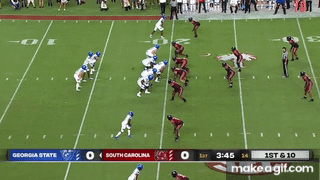
The Panthers have decent numbers in the box and get a 4-yard run out of it. Carolina prefers that two-high safety look and will be very reluctant to stack the box, so the ability to run the ball will be there. Also note that Carolina’s linebackers do not flow to the ball very well on this play and get blocked; this is a consistent theme.
A couple plays later, on third down, the Gamecocks bring a blitz and leave the boundary corner in man coverage by himself:
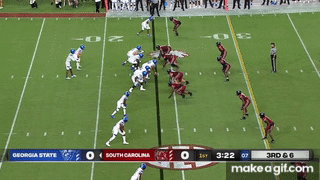
Carolina’s corners are extremely skilled in man coverage, so this game will be a colossal challenge for Arkansas’ mostly-new receiving corps.
It’s a different story for the Carolina defensive front, which improved over the course of 2021 but still struggles against the run. The aforementioned two-high safety look contributes to that, but when the Gamecocks backed off on third-and-long, the Panthers were able to run it right up the middle:
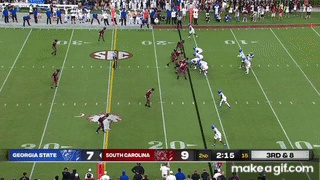
Kendal Briles loves to run the ball on passing downs — 45%, 15th-highest in the country — so the Hogs may try an unexpected run if the Gamecocks back their secondary up.
Here’s how that scheme translates on the stat sheet:

This game features one of the nation’s best passing games against one of the nation’s best pass defenses. Carolina won’t get much of a pass rush and faces a high risk of being torched by a big play, but the simple act of completing passes against them is not easy. Georgia State completed just 7 of 29 passes, so Carolina, which ranked 24th nationally in opponent completion percentage a year ago, is already 1st in the nation after one week. The Gamecocks also deflected nine passes (Arkansas had two, by contrast).
Run defense is a different story. The Gamecocks saw their talent depleted up front at the end of the Muschamp era and are very much rebuilding. Six opponents rushed for 200 yards on them last year, and Georgia State made it seven in 14 games last week. A total lack of disruption of the run game is a major issue.
Because of this, teams tend to be very run-heavy against the Gamecocks, who have a harder time disrupting the run than they do the pass:

This iteration of the data has the Hogs with the nation’s best passing game on early downs, and Carolina with the 3rd-best passing defense on early downs. There’s your matchup to watch. I think the Hogs can run the ball just fine, but in order to score enough points to overcome the injuries on defense, they’ll need to hit some early down throws.
You can probably guess the Arkansas offense strategy: run the dang ball. Briles trusts Jefferson with some early-downs RPOs, but the main goal is to get downhill and pound a weaker Gamecock front into submission. If Carolina is forced to bring help to the run defense, then the objective of the old Baylor offense comes into view for the Hogs, as the Razorbacks’ very wide splits on the outside will make it very hard for Carolina’s secondary to cover the entire field with an extra guy in the box.
Personnel
Defensive Line
- Zacch Pickens
- Alex Huntley
- Jordan Burch
- Jordan Strachan
Pickens is the veteran here, and is expecting a big year, but he failed to record a stat against Georgia State. Strachan is a veteran edge rusher who had 10.5 sacks back in 2020. Burch and Huntley are career rotational players who have been elevated into full-time starting roles this year.
Considering the run game struggles, this line is actually decent. Herring’s old Hog defenses had very productive defensive lines, and this unit is in on a lot of tackles.
Linebackers
- Brad Johnson
- Mohamed Kaba
Johnson is the veteran, a sixth-year player who had 74 tackles last season. Kaba is a new starter. I’m not 100% sure, but on film, it sure looks like this position group is the defensive weakness.
Corners and Nickels
- Darius Rush
- Cam Smith (NB)
- Marcellus Dial; 3 pass deflections in Week 1
Safeties
- RJ Roderick
- Devonni Reed
Rush, Smith, and Dial are the danger. All are veterans. Smith in particular is one of the best nickels in college football and is a preseason first-team all-SEC defensive back.
When South Carolina has the ball
Just a week ago, I would tell you that I was not worried about this side of the matchup at all, even with Spencer Rattler in a Gamecock uniform. While South Carolina didn’t do anything impressive on offense last week, the injuries to Catalon and Slusher now are cause for concern. The Gamecocks still aren’t scary, but they have a fighting chance now.

The Razorback defense is quite good and killing promising drives (five scoring chances for Cincinnati came up empty last week), but South Carolina struggles to even get promising drives.
Against Georgia State (who has a solid defense for a Sun Belt team), the Gamecocks managed just 38% success and 0.60 points per successful play. Rattler was not good: just 36% success and a dismal 3.6 adjusted net yards per pass attempt. He threw two picks.
He cannot be completely discounted. He has a live arm that’s capable of making hard throws look easy:
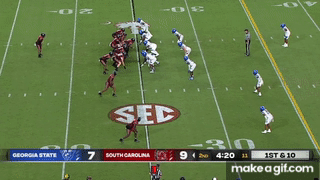
The natural talent is undeniably there. His issue at Oklahoma was improvisation. Lincoln Riley’s offense, after having Baker Mayfield and Kyler Murray, is big on letting a talented quarterback improvise. The Sooners wanted him to dance around in the pocket to buy time and get the defense out of position.
That became Rattler’s problem. He just wasn’t as good as his predecessors at decision-making on improvisation plays. The longer he danced around in the pocket, the higher the risk of something bad happening.
That doesn’t seem to have changed:
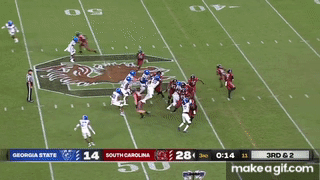
Rattler seems like the type of quarterback who would really struggle against Barry Odom’s rush-3, drop-8 zone defense. On a bad enough day, he’s capable of having a Matt Corral six-interception outing.
That said, all of his improvisations don’t necessarily go wrong. Here, he inexplicably ignores his first read (the wide-open hitch at the bottom of the screen) and instead creates a much bigger play:
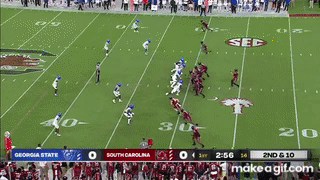
Very few quarterbacks in the country are capable of making that throw, much less on the run.
Of course, Odom might also want to think about getting some pressure, given the state of the Gamecock offensive line. Rattler was sacked three times and pressured on a third of his dropbacks. Both tackles struggled to make blocks in pass pro:
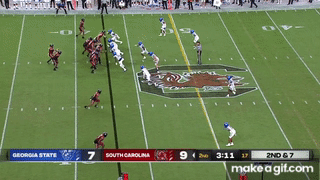
Other times, miscommunication led to blockers not being picked up:
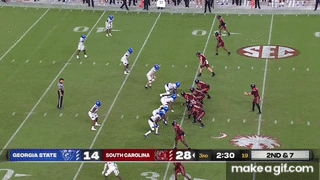
And this just looks like a wrong protection call:

Offensive line is a serious concern for Carolina. They struggled in both run blocking and pass protection last year, and the same concerns were evident against Georgia State. Everything an offense tries to do is made more difficult by bad line play.
Schematically, offensive coordinator Marcus Satterfield is a longtime Matt Rhule assistant, at Temple, Baylor, and even the Panthers in 2020. He is certainly not the most well-liked coach in Columbia, as fans have been mostly disappointed with the Gamecock offense thus far.
As per the Rhule offense, Carolina will run a lot of RPOs with zone runs attached. They’d like to use a gap run scheme to control the game on the ground, but that doesn’t suit their capabilities right now, due to bad line play.
Here, they try a Dive concept near the goal line, and Georgia State blows it up:
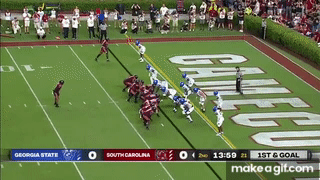
Good job by the back to bounce it outside and draw a horse collar penalty, but there will multiple missed blocks in there.
Personnel
Quarterback
- Spencer Rattler; -11 EPA, 36% Success, 0.82 Explosiveness
The Gamecocks are all-in on their quarterback. They’ll use a ton of five-wide looks to give Rattler a chance to use his athleticism to make something happen. They will likely be pass-heavy: about 50-50 run-pass on early downs, as their run game is not good.
I suspect that with the Razorback injuries, we’ll see the Hogs go heavy zone and force Rattler to make quick reads and difficult throws into tight coverage. Going with a Dime package makes it harder to stop the run and get a pass rush, but as we’ve seen, the Gamecock offensive line is bad enough that the Hogs can probably get away with it.
Running Back
- MarShawn Lloyd; 11 rushes, -0.19 EPA/Rush, 27% Success, 0.48 Explosiveness
- Juju McDowell; 7 rushes, -0.34 EPA/Rush, 14% Success, 0.16 Explosiveness
The Gamecocks ranked 114th in the nation in EPA+/Rush last season and then saw leading rusher Kevin Harris off to the NFL. Lloyd was statistically the Gamecocks’ worst back last year, and Carolina found no running room in traditional handoffs.
In terms of yards, Carolina’s leading rusher was actually a tight end, Jaheim Bell. The Gamecocks have invented a new position for him that they call “wide back”. Here’s what one of his “rushes” looks like:
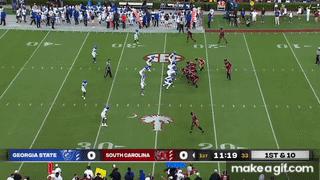
This is actually an RPO, with Rattler making the read pre-snap. Here, note the same setup as Rattler hands off on the inside zone (which goes nowhere):
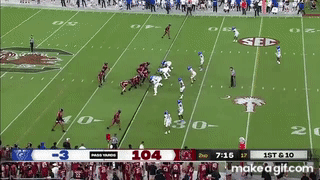
Bell will occasionally get a traditional carry, like this toss sweep:
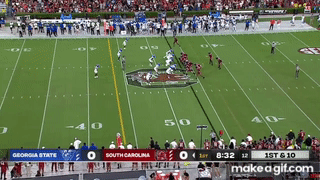
For the game he had seven rushes for 39 yards and four catches for 18 yards.
Receivers
- Jalen Brooks; 4 targets, +8 EPA, 100% Success, 1.35 Explosiveness
- Antwane Wells; 7 targets, +3 EPA, 43% Success, 0.46 Explosiveness
- Josh Vann; 1 target, +1 EPA, 100% Success, 0.37 Explosiveness
- Xavier Legette
- Ahmarean Brown
- Austin Stogner (TE)
Vann was supposed to be the main guy entering the year after totaling +44 EPA last season, but he’s off to a slow start with just one target in the opener. Instead, Jalen Brooks caught all four targets for 88 yards and 100% success. He entered the season with 25 catches for 281 yards in his career.
Offensive Line
- Jaylen Nichols
- Vershon Lee
- Eric Douglas
- Jovaughn Gwyn
- Dylan Wonnum
Here’s the issue for the Gamecocks. Against Georgia State, South Carolina averaged 0.2 yards before contact per rush. Their quarterback was sacked three times and pressured several others. Only 21% of their rushing attempts gained 6+ yards. This unit needs a good game for Carolina to have much of a chance.
Keys to the Game
Let Rattler make his own mistakes. Barry Odom’s defense has been excellent against inexperienced or overzealous quarterbacks. Rattler fits nicely into the second group. The Razorbacks need to contain the run with just five or six in the box and then sit with two (or three) high safeties and force Spencer Rattler to repeatedly make good decisions. With Catalon and Slusher out, it won’t be easy, but it’s the best shot to shut this offense down.
Punish the defense at the line of scrimmage. Expect the plan to be similar to Cincinnati: ground-and-pound with an efficient rushing attack and safe throws. South Carolina may struggle to consistently slow down the run with just six defenders in the box, so the Hogs can afford to be conservative until the Gamecocks start taking some risks.
Watch out for Beamer Ball. Against Georgia State, the Gamecocks blocked two punts for touchdowns, had a long punt return, and faked a field goal. They’ll use special teams to steal points and possessions. In a game where they’re gunning for a big road upset, expect all the stops to come out.
The latest from Fayette Villains, straight to your inbox
Enter your email to subscribe and receive new post alerts and other updates. You can unsubscribe at any time.
